| home page |
latest
news |
news
archive 2016 |
news
archive 2015 |
news
archive 2003-2010 |
|
Click
on a thumbnail to
enlarge.
OCTOBER 2014The October clubnight was a
bit of a break from the usual routine – it was a trading tables event
that attracted many interesting offerings, but also seemed to provide a
more relaxed atmosphere to discuss items than at public events.
The competition was ‘Military Toys’, and first prize went to Graham Bridges for his Arnold Jeep. Second was Michael Driver’s South African combat vehicle. Third was the display of Sentry Box, River Series and Brimtoy models by Hilary Gatward, and fourth prize went to Bob Collins for his ‘Berthing Plan' and ship models.
Click
on a thumbnail to
enlarge.
SEPTEMBER 2014 The September clubnight was a 'speed-fest' with Geoff
Holden. With a display of models of record-breaking vehicles
ranging from Kellogg’s cereal packet give-aways to the large-scale
model of the Golden Arrow made by the makers of the original bodywork,
we saw the interest generated (in the earlier years at least) by those
who strove to go ever faster – despite the risks to life and
limb! Even today the pursuit of speed seems to be an obsession of
media programmes such as Top Gear, however irrelevant it may be to the
realities of everyday motoring. Models displayed ranged from
conventional diecasts, tinplate and plastics to Bakelite and even
fold-out tin items given away with comics. Geoff is a specialist
in speed record models and memorabilia, and offers interesting items
for sale on eBay under his seller name ‘quest4 speed’. The September clubnight was a 'speed-fest' with Geoff
Holden. With a display of models of record-breaking vehicles
ranging from Kellogg’s cereal packet give-aways to the large-scale
model of the Golden Arrow made by the makers of the original bodywork,
we saw the interest generated (in the earlier years at least) by those
who strove to go ever faster – despite the risks to life and
limb! Even today the pursuit of speed seems to be an obsession of
media programmes such as Top Gear, however irrelevant it may be to the
realities of everyday motoring. Models displayed ranged from
conventional diecasts, tinplate and plastics to Bakelite and even
fold-out tin items given away with comics. Geoff is a specialist
in speed record models and memorabilia, and offers interesting items
for sale on eBay under his seller name ‘quest4 speed’. The competition followed
the theme of the presentation, and first prize went to a display of
CIJs from John Garside. Second was Gary Maslin’s Bakelite Golden
Arrow from the A.G.L. Ranlite Series. Third prize went to Michael
Driver for a Dinky 23m Thunderbolt Racing Car
in its box, and a trade box for 23s/222 Streamlined
Racing Car with a selection of the models in various colours.
Fourth was a model of the gas-powered Blue Flame belonging to Roger
Coles. The competition followed
the theme of the presentation, and first prize went to a display of
CIJs from John Garside. Second was Gary Maslin’s Bakelite Golden
Arrow from the A.G.L. Ranlite Series. Third prize went to Michael
Driver for a Dinky 23m Thunderbolt Racing Car
in its box, and a trade box for 23s/222 Streamlined
Racing Car with a selection of the models in various colours.
Fourth was a model of the gas-powered Blue Flame belonging to Roger
Coles.
Click
on a thumbnail to
enlarge.
AUGUST
2014
|
 |
 |
 |
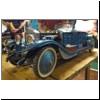 |
Click
on a thumbnail to
enlarge.
JULY 2014
At the July clubnight we
all enjoyed the annual fish and chip supper – despite it being one of
the warmest nights of the year so far! The competition was ‘Toys
and Models from Latin America’ and clearly stretched the brain cells or
collections of our members as the number of entries was somewhat below
average. However, all the models
displayed were interesting and unusual.
First prize was for Brian Gatward’s Chico Volvo trucks. Second prize went to Michael Driver for a hand-made copper dump truck – a souvenir from a copper mine. Third prize went to Bob Westerbeke for a Buby 1973 Ford Falcon complete with original box. Fourth prize went to Allan Feldman for a selection of Solido Mercedes-Benz C111s, of which one was made in Brazil (front right in the picture).
First prize was for Brian Gatward’s Chico Volvo trucks. Second prize went to Michael Driver for a hand-made copper dump truck – a souvenir from a copper mine. Third prize went to Bob Westerbeke for a Buby 1973 Ford Falcon complete with original box. Fourth prize went to Allan Feldman for a selection of Solido Mercedes-Benz C111s, of which one was made in Brazil (front right in the picture).
 |
 |
 |
 |
Click
on a thumbnail to
enlarge.
JUNE 2014
At the June clubnight, Tim
Morris of the Brooklands
Museum Trust gave us a fascinating and very well illustrated
insight into the history of the Brooklands site. We use the term
‘site’ because if we think of Brooklands just in terms of motor
racing, we miss a large proportion of
its history, even though it was the
first custom-built racing circuit in the world. At the time of the track’s
conception, British motoring enthusiasts were frustrated by the 20mph
speed limit, so the circuit planned by Hugh and Ethel Locke King
offered the chance to push cars to their limit away from the public
roads. During 1906-7 some 2000 navvies poured around 200,000 tons
of concrete to create the structure, some of which can still be seen to
this day. The etiquette of motor
racing was initially derived from that of horse racing, with early
drivers wearing coloured silks, and bets being taken on the races.
But it was the use of Brooklands during the pioneering days of aviation that led to the aircraft factories during the first world war, the use by flying clubs during the inter-war period and the site’s importance in aircraft design and construction during the second world war. Some 3000 Wellington bombers were built there, along with Hurricanes, and Barnes-Wallace developed the bouncing bomb at Brooklands. Due to wartime buildings and breaks in the track, use for racing was no longer possible, and after the war the site was taken over by Vickers, producing civil aircraft including the VC10 and Concorde. In total over a period of 80 years some 18,600 aircraft were built, of around 260 types.
With the closure of Vickers, the site has now been developed for business and leisure use, and Mercedes-Benz World occupies a large area including parts of the original track. However the Brooklands Museum maintains many of the historic buildings, and has collections ranging from pedal bicycles through to full-size aircraft via historic cars. The Chobham Bus Museum also now resides at Brooklands. The Brooklands Trust has great plans for the future, and currently hosts a wide variety of motoring events – even offering itself as a wedding venue!
The competition was on the theme of Brooklands, and first prize went to Robert Newson for a pair of Scamold racing cars (including an original box) made at Brooklands by Scale Models Ltd. from 1938 to 1948. Second prize went to Michael Driver for a collection of three Dinky Racers (35b/200) produced from 1936-1957 and based on an MG R Type which raced at Brooklands in the 1930s. Third place went to a Vickers Viscount from TIm Morris in early BEA livery, and fourth to Bob Collins for a pair of Dinky Auto-Union Racing Cars complete with an original trade box.
But it was the use of Brooklands during the pioneering days of aviation that led to the aircraft factories during the first world war, the use by flying clubs during the inter-war period and the site’s importance in aircraft design and construction during the second world war. Some 3000 Wellington bombers were built there, along with Hurricanes, and Barnes-Wallace developed the bouncing bomb at Brooklands. Due to wartime buildings and breaks in the track, use for racing was no longer possible, and after the war the site was taken over by Vickers, producing civil aircraft including the VC10 and Concorde. In total over a period of 80 years some 18,600 aircraft were built, of around 260 types.
With the closure of Vickers, the site has now been developed for business and leisure use, and Mercedes-Benz World occupies a large area including parts of the original track. However the Brooklands Museum maintains many of the historic buildings, and has collections ranging from pedal bicycles through to full-size aircraft via historic cars. The Chobham Bus Museum also now resides at Brooklands. The Brooklands Trust has great plans for the future, and currently hosts a wide variety of motoring events – even offering itself as a wedding venue!
The competition was on the theme of Brooklands, and first prize went to Robert Newson for a pair of Scamold racing cars (including an original box) made at Brooklands by Scale Models Ltd. from 1938 to 1948. Second prize went to Michael Driver for a collection of three Dinky Racers (35b/200) produced from 1936-1957 and based on an MG R Type which raced at Brooklands in the 1930s. Third place went to a Vickers Viscount from TIm Morris in early BEA livery, and fourth to Bob Collins for a pair of Dinky Auto-Union Racing Cars complete with an original trade box.
 |
 |
 |
 |
Click
on a thumbnail to
enlarge.
MAY 2014

 Like a magician pulling
white rabbits from a top hat, at our May clubnight Neil Baldry
(pictured left) presented us with a table-full of items on the theme of
streamlined models. The gradual increase in interest in the style
started in the earliest years of the 20th century. As with so
many innovations, the original aim of improving the performance of
racing cars (initially by improving on the flat-fronted radiator)
gradually crossed over to production cars - and even buses and trucks,
not to mention trains and planes.
Like a magician pulling
white rabbits from a top hat, at our May clubnight Neil Baldry
(pictured left) presented us with a table-full of items on the theme of
streamlined models. The gradual increase in interest in the style
started in the earliest years of the 20th century. As with so
many innovations, the original aim of improving the performance of
racing cars (initially by improving on the flat-fronted radiator)
gradually crossed over to production cars - and even buses and trucks,
not to mention trains and planes.The competition was on the same theme, and first prize was taken by Brian Gatward with his ‘by appointment’ Chad Valley tinplate ‘Merlin’ locomotive complete with original box. Second prize went to Michael Driver’s three trains by Dinky, Crescent and Tootsietoy. Third prize went to Robert Newson’s display of Chrysler and DeSoto Airflows.
The innovative Airflow was one of the first mass-production streamlined cars. With its unitary construction, it was the forerunner of the modern motor car, and its dramatic new styling made it a popular subject for contemporary toy manufacturers. The models in the display are as follows (clockwise from bottom left in the third photograph below).
- Bottom left - Diecast lead Matchbox-size model by Tip-Top Toy.
- Middle left - slush-cast lead model by CAW (Charles A.Wood).
- Top left - unknown slush-cast lead model which seems to be based on the Dinky Toy. Rather crudely made with closed wheel arches, but still with quite good detail. The wheels were rubber tap washers!
- Top right - this slush-cast lead model is the odd man out, as the other toys here are all American. The mould was made by Metal Cast Products of New York, but the toy was made by Fun Ho! of New Zealand. Not many people know that Fun Ho! made lead toys in the 1930s from American moulds before introducing their aluminium models after the war.
- Middle right - slush-cast lead Airflow by Kansas Toy & Novelty Co.
- Bottom right - the relatively common Tootsietoy zinc diecast model from 1935.
 |
 |
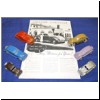 |
 |
APRIL 2014
 April’s
clubnight featured a fascinating ‘bygones’ quiz presented by Terry
Ridgley (pictured left). Identifying the origin of, or original use for
a selection of artifacts certainly stretched the grey matter of the
assembled club members! We all learned something from the
objects, most of which Terry apparently unearthed himself.
April’s
clubnight featured a fascinating ‘bygones’ quiz presented by Terry
Ridgley (pictured left). Identifying the origin of, or original use for
a selection of artifacts certainly stretched the grey matter of the
assembled club members! We all learned something from the
objects, most of which Terry apparently unearthed himself.
 Mike Samuel was belatedly presented with the Participation
Award trophy by chairman John Ward (pictured right).
Mike Samuel was belatedly presented with the Participation
Award trophy by chairman John Ward (pictured right).
The subject of the competition was toys and models from the USA, and an excellent selection was on display, some of which can be seen in the photos here. First prize went to Robert Newson for a display of models produced from moulds made by Metal Cast Products Co., who supplied moulds for home casting or ‘cottage industry’ casters during the depression years. Second prize went to Bob Collins for a very unusual Louis Marx tinplate bridge, complete with traffic. Third was a 1930s blue Airflow car by Kingsbury of Keene, New Hampshire, belonging to Colin Bull. Fourth was a group of Manoil Happy Farm figures from John Garside.
Click
on a thumbnail to
enlarge.
 April’s
clubnight featured a fascinating ‘bygones’ quiz presented by Terry
Ridgley (pictured left). Identifying the origin of, or original use for
a selection of artifacts certainly stretched the grey matter of the
assembled club members! We all learned something from the
objects, most of which Terry apparently unearthed himself.
April’s
clubnight featured a fascinating ‘bygones’ quiz presented by Terry
Ridgley (pictured left). Identifying the origin of, or original use for
a selection of artifacts certainly stretched the grey matter of the
assembled club members! We all learned something from the
objects, most of which Terry apparently unearthed himself. Mike Samuel was belatedly presented with the Participation
Award trophy by chairman John Ward (pictured right).
Mike Samuel was belatedly presented with the Participation
Award trophy by chairman John Ward (pictured right).The subject of the competition was toys and models from the USA, and an excellent selection was on display, some of which can be seen in the photos here. First prize went to Robert Newson for a display of models produced from moulds made by Metal Cast Products Co., who supplied moulds for home casting or ‘cottage industry’ casters during the depression years. Second prize went to Bob Collins for a very unusual Louis Marx tinplate bridge, complete with traffic. Third was a 1930s blue Airflow car by Kingsbury of Keene, New Hampshire, belonging to Colin Bull. Fourth was a group of Manoil Happy Farm figures from John Garside.
 |
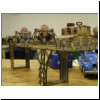 |
 |
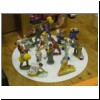 |

 At
the November clubnight Adrian Little gave us an insight into the work
that went into the production of the two-volume book
At
the November clubnight Adrian Little gave us an insight into the work
that went into the production of the two-volume book 

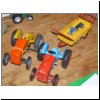





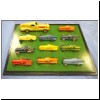



 The
August clubnight was an eye-opener for the huge variety of Rolls-Royce
models. Kevin Bailey showed slides of a wide selection from his
personal collection, and added in some information about the real cars
and the company that made them. In addition his own ‘Roller’ was
parked outside, and he also displayed some of his collection including
improved items.
The
August clubnight was an eye-opener for the huge variety of Rolls-Royce
models. Kevin Bailey showed slides of a wide selection from his
personal collection, and added in some information about the real cars
and the company that made them. In addition his own ‘Roller’ was
parked outside, and he also displayed some of his collection including
improved items.